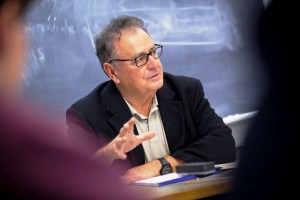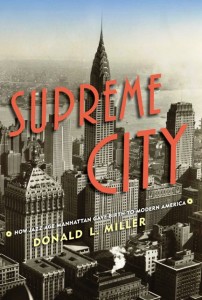By Geoff Gehman ’80
Donald L. Miller believes that cities can be read like books. The historian thinks that histories of cities should read like novels. His latest history of a city reads like an epic novel.

Donald L. Miller
Supreme City: How Jazz Age Manhattan Gave Birth to Modern America (Simon & Schuster) is a monumental portrait of the monumental 1920s, when men and women with monumental ambition made Midtown Manhattan the capital of everything from clothes to cosmetics, skyscrapers to sports. Miller peoples his tectonic-shifting, shimmering story with immigrant builders and Native American construction workers, gangsters and nightclub entertainers, athletes and promoters, tabloid journalists, and book publishers like Richard Simon and Max Schuster, who created the crossword-puzzle craze. Among the stranger-than-fiction, capital-C characters are automobile mogul Walter Chrysler, whose Chrysler Building has gargoyles shaped like car radiator caps, and Prohibition mogul Owney Madden, who said of running an illegal brewery: “It’s better than killing somebody.”
The book has received favorable feature reviews in many major national media outlets, including The New York Times, The Wall Street Journal, Vanity Fair, The Washington Post, The Philadelphia Inquirer, and The Daily Beast. Miller was interviewed about the book on the Leonard Lopate Show on New York Public Radio.
Miller, the John Henry MacCracken Professor of History, recently discussed Supreme City in his office at Ramer History House. We talked near a photograph of him with actor Tom Hanks, co-producer of an upcoming HBO series based on Masters of the Air, Miller’s history of America’s Nazi-battling “bomber boys.”
Q: You’re well-known for enlisting Lafayette students to help you research your books, for training them to be “amateur urban archaeologists.” How did they help you excavate and build Supreme City?
A: The kids have just been terrific. Tyler Bamford [’12] researched the Holland Tunnel and the GW Bridge. Margarita Karasoulas [’08] did a lot of the research on the rise of the tabloids. Christy Fic [’10] did a lot of work on the Ruth Snyder case. [The Daily News became enormously popular with its sensational coverage of the 1928 trial and execution of the unfaithful Snyder, who was electrocuted for murdering her husband].

Supreme City: How Jazz Age Manhattan Gave Birth to Modern America by Donald L. Miller
Sean Grim [’14] was my EXCEL team leader this year. In addition to working extensively on the bibliography, he helped me collect photographs for the book and created a slide show, for my author’s website, of New York in the 1920s, set to the music of Duke Ellington.
I want my EXCEL students to come out of here with a sense of themselves, that they can tackle big independent projects, that they can take tough criticism—I’m very tough on them—and learn from it. If they can write and read critically and keep careful records of everything, they’ll have real marketable skills that can take them in many directions.
Q: What was your first favorite building in Manhattan, the first skyscraper that made your spirit scrape the sky?
A: The Chrysler Building. Even more than the Empire State Building, which is taller, it seemed to command the skyline. It caught my attention from the Pulaski Skyway; I was around nine at the time. I don’t know where we were going or why we were on that damned thing. All I know is that you got a great view of Manhattan as a wonder city.
I’ve always been drawn to cities. My passion for them began in my hometown of Reading while walking with my grandfather, a Slovak immigrant steelworker. We’d walk by firehouses, barbershops, movie theaters, saloons, and rail stations, where we’d see long coal trains coming from Anthracite Country, where my father’s family was from. In summers I would visit New York with my Jersey City relatives. I loved the clamorous excitement of the place. It just exploded on me.
Q: Supreme City is crammed with strange bedfellows, night-and-day partners, and archrivals, reformers who needed reforming: radio pioneers David Sarnoff and William Paley, boxer Jack Dempsey and boxing promoter Tex Rickard, beauty evangelists Elizabeth Arden and Helena Rubenstein. At times you must have felt like Noah, captain of the Manhattan Ark.
A: You are Noah; it’s your ark and you get to decide who’s on it. All these wonderful characters kept coming at me, characters who had independent careers but didn’t really become transcendent until they joined forces. Dempsey could punch and Rickard could get the gate, and that’s what was needed for big-time boxing to really take off. For radio to really take off you needed a technological genius like Sarnoff and a promotional genius like Paley. And I don’t think Rubenstein could have conquered New York without Arden. Together, they revolutionized the beauty industry in a matter of six or seven years.
Q: Despite the bizarre fact that they never formally met, despite operating salons three blocks apart on Fifth Avenue.
A: My nephew, who’s a budding intellectual, said to me, “Why are you writing about hairdressers?” I said, “They’re not hairdressers. They’re fashion entrepreneurs and they changed women’s lives.” Their influence can still be felt today.
Q: Another pivotal female in your story is Texas Guinan, the night-club queen who by challenging Prohibition challenged other women to lobby for the repeal of Prohibition.
A: There was this idea that the Prohibitionists carried in their heads that the only opposition to Prohibition was from men who drank. Guinan put the lie to that. Characters like Guinan are usually dealt with superficially by historians, but she had depth. Here was an excellent business woman, a devout Catholic who didn’t drink, a has-been movie actress who had a second career because of an opportunity—Prohibition—that fell into her lap. Like Gatsby, she made up her own past. She was self-invented.
I do point out that for every one of these people who made it there were a hundred who failed. Jack Dempsey made an interesting remark about his first time in the city. “I thought it was New York that wanted me,” he said. “But I needed New York. It was a hard city to break into because they didn’t need me.”
Q: What void of history did you want to fill in Supreme City?
A: The story of moving from downtown to uptown is an old story. But I don’t think writers have ever really peopled the story with a wide range of remarkable characters. I didn’t want my story to be only about millionaires who were Horatio Alger figures. I write about dockworkers, immigrant women in garment factories, the Mohawk Indians who built skyscrapers.
I see the musical producer Florenz Ziegfeld, not F. Scott Fitzgerald, as the best representative of the Jazz Age—its creativity, experimentalism, risk-taking, and excesses. His serial adulteries. His spectacular gambling habits. His willingness to change careers midstream. The Ziegfeld Follies got a little stale, and all of a sudden he produced Show Boat and astounded everybody. He was the only producer on Broadway who featured black entertainers onstage with white entertainers.
I thought Ziegfeld was a terrific Jazz Age character. He had that Greek sense of arête, where your strongest characteristics can be your fatal weakness.
Q: Writing a book, especially a monumental book, is an odyssey of changes and surprises. Was there a character in Supreme City who surprised you by changing from minor to major, someone who grew on you?
A: The bootlegger Owney Madden grew on me. He was from another place—an Irish kid from England—who was perfectly equipped to make it in Prohibition. He had exactly the right skill, if you can call them that. He was very bright. He had vision. He saw life as a Darwinian struggle. He realized he had to adapt or die because the violent street gangs he led in Hell’s Kitchen were being closed down by the cops. So he makes the jump into Prohibition. He hooks up with the people who founded the first New York nightclubs. He buys the Cotton Club and he’s instrumental in hiring Duke Ellington. He was the king of the Big Stem, as they called Broadway. He was a character who could take me to a lot of different places, who had legs.
I like the fact that he kept pigeons on the roof, too. I always loved that Brando kept pigeons on the roof in On the Waterfront.
Q: Was there a non-academic passion you got to indulge, like jazz or baseball?
A: I loved writing about boxing. I like how boxing has been taken seriously by major writers like Joyce Carol Oates, author of the fabulous book On Boxing. Writers are drawn to boxing because it’s all about stories. Tex Rickard came up with that idea that every financially successful fight has to have a story surrounding it.
I am a committed believer in narrative history. I think one of the great myths about narrative history, perpetuated by historians who can’t write it, is that it doesn’t carry analysis. The art of narrative is to be able to tell a story while effortlessly weaving in a point of view. I like to make interesting connections between characters, connections that surprise readers. It was Dante who said that hell is the place where nothing connects.
I believe strongly in the fallacy of hindsight. Hindsight is supposed to give you perspective, but hindsight can also distort. My friend David McCullough tells me all the time: The most inaccurate phrase in the English language is “the foreseeable future.” I try to capture people at the moment they make decisions, unaware of what’s ahead or posterity’s judgment.
I work hard to break my students of the habit of writing topically, of dividing their research papers into neatly defined topics like politics, culture, and what-not. Life isn’t led that way. It’s led consecutively. It’s a narrative, an evolving thing.


4 Comments
Sounds interesting. I hope I have the opportunity to meet Prof. Miller some day.
Interesting that in this review of a book for which part of the title is “jazz age,” there is no reference to jazz or the people who made it. I assume this is not true of the book. Certainly, Harlem had a lot to do with the beginnings of the Jazz age, if not its denouement.
There’s a chapter on Duke Ellington.
Comments are closed.